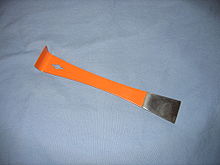Beekeeping/Hive Tool

Usage
[edit | edit source]- Hive tools can be used for
-
- loosening hive bodies and frames.
- scraping off excess bur comb or propolis from hive parts.
- removing a bee sting from the body
- Hive tools, when jointly used for beekeeping, should not be used for
-
- Mixing paint, varnish or chemicals
Selecting a Design
[edit | edit source]There exist multiple designs of hive tools, but in truth most any kind of pry bar with a blade will work. If you find that money is burning a hole in your pocket, feel free to invest in a high quality Teflon coated hive tool that would likely outlast any beekeeper. Hive tools generally come in 7 and 10-inch varieties. If possible, before purchasing, see how the tool fits in your hand, and buy the one you are most comfortable with. Although it may not seem like an issue, the color of your hive tool may be important. If possible, purchase a brightly colored hive tool or paint it such. A brightly colored hive tool will stand out a lot better when dropped. It is rather difficult to continue working if you lose your tool.
Purchasing
[edit | edit source]Hive tools are sold by nearly every bee keeping supply house, but similar items can be found at most every hardware store. Simply look for a quality scraper/nail puller type of tool.
Maintenance
[edit | edit source]- It is advisable to sharpen the blade of a hive tool when needed. It is difficult to predict the intervals when such would need to be done, but most beekeepers do so at least once a year.
- If a hive tool is used on a hive that may be infected by disease it is often advisable to clean the tool by flame.